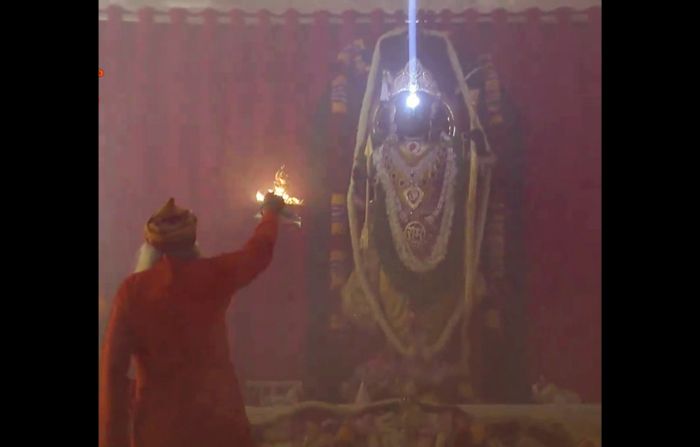- Friday, April 18, 2025
Prime minister Narendra Modi hailed the ‘wonderful’ event and watched it on a device in the north-eastern state of Assam, where he was campaigning for the upcoming general elections.

By: Shubham Ghosh
THE occasion of Ram Navami, which is held to celebrate the birth of Lord Ram every year, on Wednesday (17) witnessed special scenes at the temple dedicated to the Hindu god in Ayodhya in the northern Indian state of Uttar Pradesh.
The sun’s rays fell on the forehead of Ram Lalla (statue of child Lord Ram) in the form of a ‘surya tilak’ just a minute after noon, creating a mesmerising ambience for around two-and-half minutes. Devotees and spectators were enthralled by the scene. Pictures and videos of the beam of light measuring around 6 centimetre illuminating the statue’s forehead as priests offered prayers went viral on social media.
The event was also projected on large LED screens in almost 100 places across Ayodhya where the temple was built in the place of a 15th century mosque built by Mughal emperor Babur that was razed by Hindu nationalists in 1992.
'Surya Tilak' adorns the forehead of Ram Lalla at Shri Ram Janmabhoomi Mandir in Ayodhya.
Ram Navami wishes to all. ? pic.twitter.com/mldTURFAf3
— Indian Tech & Infra (@IndianTechGuide) April 17, 2024
It was the first Ram Navami which was held since the consecration of the temple by prime minister Narendra Modi on January 22.
The PM also tweeted about the unique celebration of Ram Navami at the temple and urged devotees of Lord Ram from across the world to witness the “wonderful” moment.
दिव्य-भव्य राम मंदिर में राम लला की प्राण-प्रतिष्ठा के बाद ये पहली रामनवमी है, जिसमें प्रभु श्री राम के सूर्य तिलक का अलौकिक अवसर भी आया है। दुनियाभर के राम भक्तों से मेरा आग्रह है कि वे इस अद्भुत क्षण का साक्षी जरूर बनें। https://t.co/jBw1J0GMOY
— Narendra Modi (@narendramodi) April 17, 2024
He watched it in a gadget after an election rally in the north-eastern state of Assam and said it was a “very emotional moment” for him.
In another post on X, he said, “After my Nalbari rally, I watched the Surya Tilak on Ram Lalla. Like crores of Indians, this is a very emotional moment for me. The grand Ram Navami in Ayodhya is historic. May this Surya Tilak bring energy to our lives and may it inspire our nation to scale new heights of glory.”
He also chanted ‘Jai Shri Ram’ during the ritual.
After my Nalbari rally, I watched the Surya Tilak on Ram Lalla. Like crores of Indians, this is a very emotional moment for me. The grand Ram Navami in Ayodhya is historic. May this Surya Tilak bring energy to our lives and may it inspire our nation to scale new heights of glory. pic.twitter.com/QqDpwOzsTP
— Narendra Modi (@narendramodi) April 17, 2024
In another post, he said, “The first Ram Navami after the Pran Pratishtha in Ayodhya is a generational milestone, weaving together centuries of devotion with a new era of hope and progress. This is a day crores of Indians waited for. Innumerable people devoted their lives to this sacred cause.”
The first Ram Navami after the Pran Pratishtha in Ayodhya is a generational milestone, weaving together centuries of devotion with a new era of hope and progress. This is a day crores of Indians waited for. Innumerable people devoted their lives to this sacred cause.
May the… pic.twitter.com/2aJMLn1hhI
— Narendra Modi (@narendramodi) April 17, 2024
The event was projected on large LED screens placed in nearly 100 places across Ayodhya.
Talking about the science that made the ‘surya tilak’ on the forehead of the black stone statue a reality, it was done with the help of mirrors and lenses. Sunrays were reflected into the sanctum sanctorum from the third floor of the temple near the pinnacle and it was done so that there is no way for direct sunlight to enter the sanctum sanctorum.
The mechanism was devised by scientists from the prestigious Indian Institute of Technology in Roorkee in the northern state of Uttarakhand in consultation with the Indian Institute of Astrophysics in Bengaluru in the southern state of Karnataka.
Earlier in the day, Ram Lalla was bathed in holy water and dressed in yellow clothes. Fifty-six types of offerings were made to the god, the temple’s chief priest said.